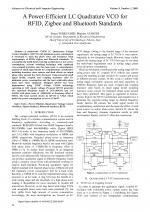| 3/2009 - 7 |
A Power-Efficient LC Quadrature VCO for RFID, Zigbee and Bluetooth StandardsTORKZADEH, P. |
| Extra paper information in |
| Click to see author's profile in |
| Download PDF |
Author keywords
power efficient, quadrature voltage control oscillator, Zigbee standard, Bluetooth standard, RFID
References keywords
circuits(5), systems(4), state(4), solid(4)
No common words between the references section and the paper title.
About this article
Date of Publication: 2009-10-26
Volume 9, Issue 3, Year 2009, On page(s): 34 - 38
ISSN: 1582-7445, e-ISSN: 1844-7600
Digital Object Identifier: 10.4316/AECE.2009.03007
Web of Science Accession Number: 000271872000007
SCOPUS ID: 77954710532
Abstract
A multi-band CMOS LC Quadrature Voltage Control Oscillator (QVCO) with minimum power consumption is developed to meet the phase noise and frequency band requirements of RFID, Zigbee and Bluetooth standards. To accomplish the multi-band receiving architecture at low power consumption, current switching technique with optimized cross-coupled transistor sizes has been used. A comprehensive analysis of small signal model for complementary architecture including transistor noise sources and their effects on output phase noise amount has been discussed. Using extracted small signal model, coupled and coupling transistor sizes for minimum power consumption and the least achievable phase noise have been optimized. Designed QVCO has been implemented using TSMC 0.18um CMOS technology operating at 1.8V supply voltage. Proposed QVCO generates two separated frequency bands of 1.65-1.85GHz and 2.4-2.5GHz with phase noise of -125dBc/Hz at frequency offset of 3MHz. The total current drawn by QVCO is 7.5mA which makes the power consumption as low as 13.5mW. |
| References | | | Cited By «-- Click to see who has cited this paper |
| [1] "IEEE Standard 802.15.1-2002", IEEE Standard for Information technology - Specific requirements Part 15.1: Wireless Medium Access Control (MAC) and Physical Layer (PHY) Specifications for Wireless Personal Area Networks (WPANs)
[2] "Specification of Bluetooth systems", Bluetooth standard publications, February 2001 [3] U. Karthaus, M. Fischer, "Fully integrated passive UHF RFID transponder IC with 16.7-uW minimum RF input power", IEEE J. Solid-State Circuits, vol. 38, pp. 1602-1608, October 2003 [CrossRef] [SCOPUS Times Cited 837] [4] R. Sheen, and C. Chen, "A wide-range phase-locked loop using a range-programmable voltage-controlled oscillator", Proc. of IEEE 43th Midwest Symp. Circuits and Systems, vol. 1, pp.526-529, August 2000 [CrossRef] [5] C. Chen, and R Sheen, "A power-efficient wide-range phase-locked loop", IEEE J. Solid-State Circuits, vol. 37, pp. 51-62, January 2002 [CrossRef] [SCOPUS Times Cited 64] [6] M. Hsia, and O. Chen, "A multiband CMOS LC Quadrature VCO for GSM/DCS/DECT and Bluetooth Systems", IEEE International Symposium of Circuit and Systems, May 2006 [7] J. Wang, J. Tan and O. Wing, "Theory of cross coupled oscillator system for RF Quadrature generation", Proc. of IEEE International Conference of Circuit and System for Communication, pp.362-265, 2002 [CrossRef] [SCOPUS Times Cited 5] [8] S. Ko, and S. Hong, "Noise property of a Quadrature balanced VCO", IEEE Microwave and Wireless Components Letters, vol. 15, no. 10, October 2005 [CrossRef] [SCOPUS Times Cited 11] [9] A. Hajimiri, and T. H. Lee, "A general theory of phase noise in electrical oscillators", IEEE J. Solid-State Circuits, vol. 33, no. 2, February 1998 [CrossRef] [SCOPUS Times Cited 1995] [10] L. Perraud, L. Bonnot, N. Sornin and C. Pinatel, "Fully integrated 10 GHz CMOS VCO for multi-band WLAN applications", Proc. of Europe Solid-State Circuits Conf, pp. 353-356, September 2003 [CrossRef] [SCOPUS Times Cited 21] Web of Science® Citations for all references: 0 SCOPUS® Citations for all references: 2,933 TCR Web of Science® Average Citations per reference: 0 SCOPUS® Average Citations per reference: 267 ACR TCR = Total Citations for References / ACR = Average Citations per Reference We introduced in 2010 - for the first time in scientific publishing, the term "References Weight", as a quantitative indication of the quality ... Read more Citations for references updated on 2025-07-07 22:55 in 49 seconds. Note1: Web of Science® is a registered trademark of Clarivate Analytics. Note2: SCOPUS® is a registered trademark of Elsevier B.V. Disclaimer: All queries to the respective databases were made by using the DOI record of every reference (where available). Due to technical problems beyond our control, the information is not always accurate. Please use the CrossRef link to visit the respective publisher site. |
Faculty of Electrical Engineering and Computer Science
Stefan cel Mare University of Suceava, Romania
All rights reserved: Advances in Electrical and Computer Engineering is a registered trademark of the Stefan cel Mare University of Suceava. No part of this publication may be reproduced, stored in a retrieval system, photocopied, recorded or archived, without the written permission from the Editor. When authors submit their papers for publication, they agree that the copyright for their article be transferred to the Faculty of Electrical Engineering and Computer Science, Stefan cel Mare University of Suceava, Romania, if and only if the articles are accepted for publication. The copyright covers the exclusive rights to reproduce and distribute the article, including reprints and translations.
Permission for other use: The copyright owner's consent does not extend to copying for general distribution, for promotion, for creating new works, or for resale. Specific written permission must be obtained from the Editor for such copying. Direct linking to files hosted on this website is strictly prohibited.
Disclaimer: Whilst every effort is made by the publishers and editorial board to see that no inaccurate or misleading data, opinions or statements appear in this journal, they wish to make it clear that all information and opinions formulated in the articles, as well as linguistic accuracy, are the sole responsibility of the author.



